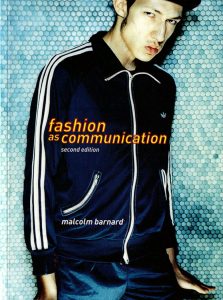‘Fashion as communication’ ch apter one can be summarised in the way that Barnard tries to find the meaning of the word ‘Fashion’. Barnard says that fashion itself has no singular meaning and can be used loosely in many different ways, words such as ‘style’ ‘dress’ and ‘clothing’ are ones that can be defined and linked by one another. “It could also be said that, while all clothing is an adornment, not all clothing is fashion”[Source 1, Page 9, Paragraph 3, Line 8] this shows how all these words are connected and can be used in different ways. A main aspect of this chapter which I found interesting was taken from Simmel and it is the concept that without the natural human instinct to be apart of social groups contrasted with the need to be seen as an individual fashion would be non-existent. Fashion exists within society because, Wilson writes, ‘we want to look like our friends but not to be clones’ The want to be an individual within society forces people to use fashion as a way to show their personal identity. Carrying on from this he says fashion trends in the western world change fast. This is because, as it says in the first chapter, the constant consumption of fashion comes from people’s desire to climb the social ladder. Keeping up with the trends suggests someones need for change in their life and in the world they live in.
apter one can be summarised in the way that Barnard tries to find the meaning of the word ‘Fashion’. Barnard says that fashion itself has no singular meaning and can be used loosely in many different ways, words such as ‘style’ ‘dress’ and ‘clothing’ are ones that can be defined and linked by one another. “It could also be said that, while all clothing is an adornment, not all clothing is fashion”[Source 1, Page 9, Paragraph 3, Line 8] this shows how all these words are connected and can be used in different ways. A main aspect of this chapter which I found interesting was taken from Simmel and it is the concept that without the natural human instinct to be apart of social groups contrasted with the need to be seen as an individual fashion would be non-existent. Fashion exists within society because, Wilson writes, ‘we want to look like our friends but not to be clones’ The want to be an individual within society forces people to use fashion as a way to show their personal identity. Carrying on from this he says fashion trends in the western world change fast. This is because, as it says in the first chapter, the constant consumption of fashion comes from people’s desire to climb the social ladder. Keeping up with the trends suggests someones need for change in their life and in the world they live in.
I want to focus on the concept of clothing as a way to climb the social ladder and develop the ideas behind it further with more research and opinions, an article I found online gives evidence supporting this theory. The title “Women ratchet themselves s up the social ladder one high heel at a time” [Source 2, title of article] gives an interesting insight into social group dynamics. This text reviews research of women’s shoe shopping in different states in America. The results show that the richer the state the more likely it is that a woman will base her shoe choice on what those around her are wearing, where as in poorer states women will try and avoid fitting in with their surrounding when choosing shoes. This text contributes to aspects of ‘Fashion as communication’ taking forward the ideas that we as a species want to fit in when in socially achieving and wealthy groups whereas in comparison want to stand out when in lower ranking social groups to distinguish yourself as an individual. I find this very intriguing as I had not considered fashion as a social construct previous to reading about it. Comparing this idea to the contents of ‘The Sociology of Taste’ the overall concept is laid out simply, questioning how fashion, as a social need, can produce “the process of collective taste”[Source 3, page 93, paragraph 4, line 6] This then comes back to the ideas within the first source, that as fashion evolves and changes so does the western world.
Fashion is a construct developed to show social status and wealth. However, fashion can also be viewed as a personal preference, not every trend is always followed and although we are told subliminally what we should and should not wear I believe that at the end of the day it is up to each individual what fashion means to them and the social group they associate with.
“Fashion seems to embrace two opposite goals—fitting in with the crowd and standing out from it”[Source 2, Paragraph 1, Line 1]
[Source 1] Book – Barnard, M.B (1996) Fashion as Communication, Routledge [Accessed 10th November]
[Source 2] Website – The University of North Carolina at Chapel Hill (2016) Women ratchet themselves up the social ladder one high heel at a time, Available from http://uncnews.unc.edu/2016/05/04/women-ratchet-social-ladder-one-high-heel-time/ [Accessed 20th November]
[Source 3] Book – Gronow, J.G (1997) The Sociology of Taste, London, Routledge [Accessed 20th November]
